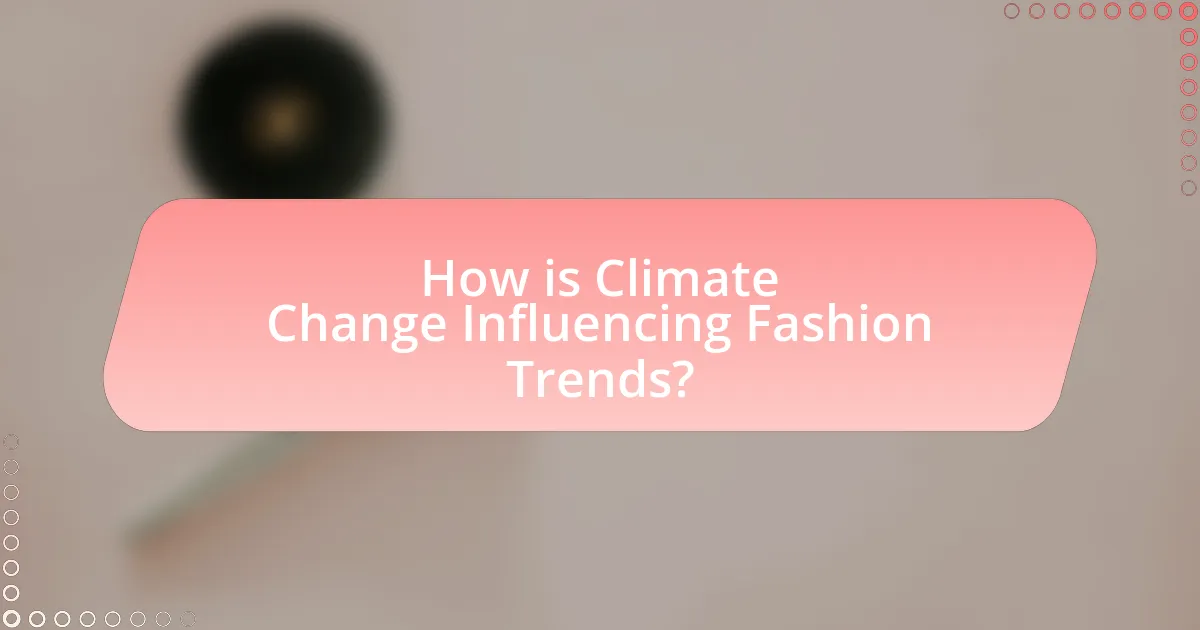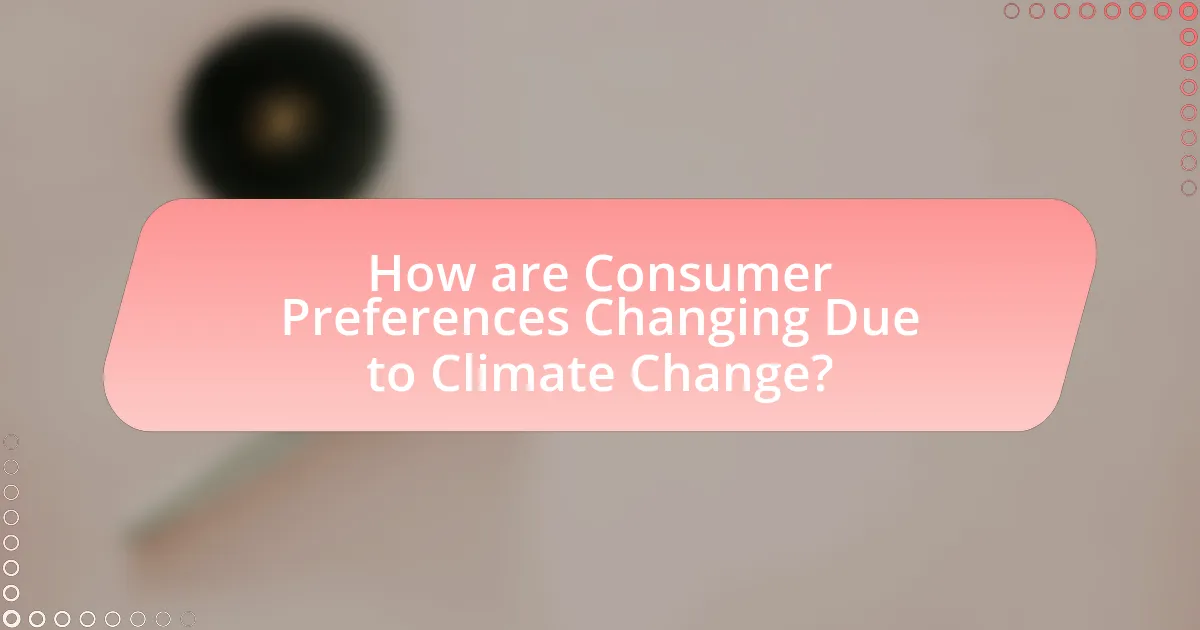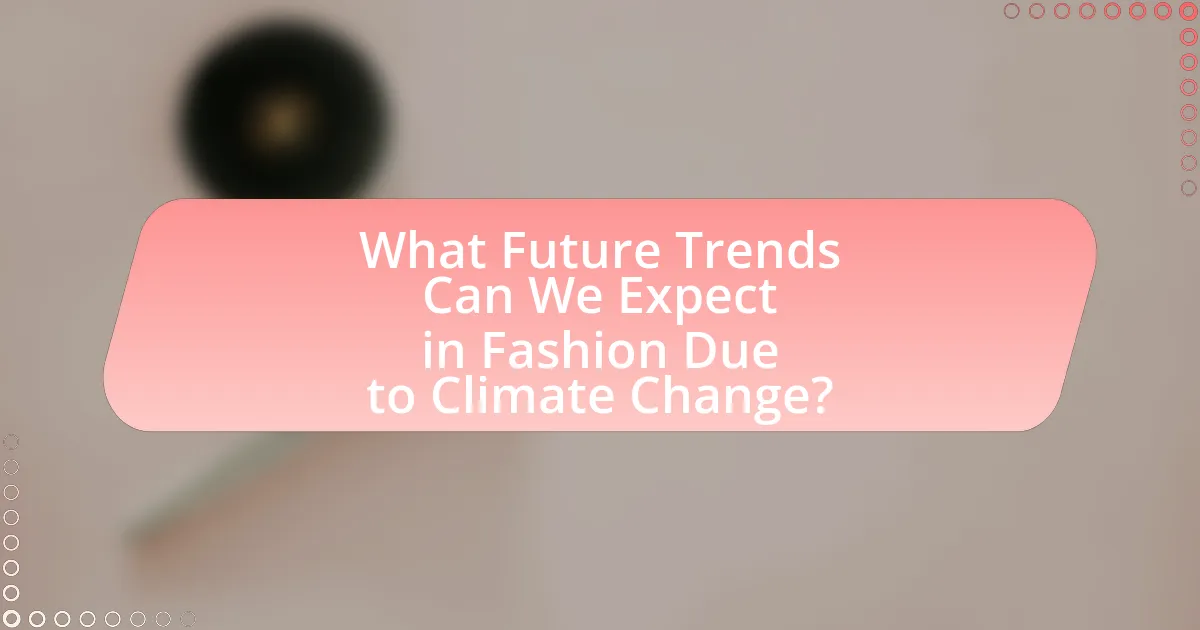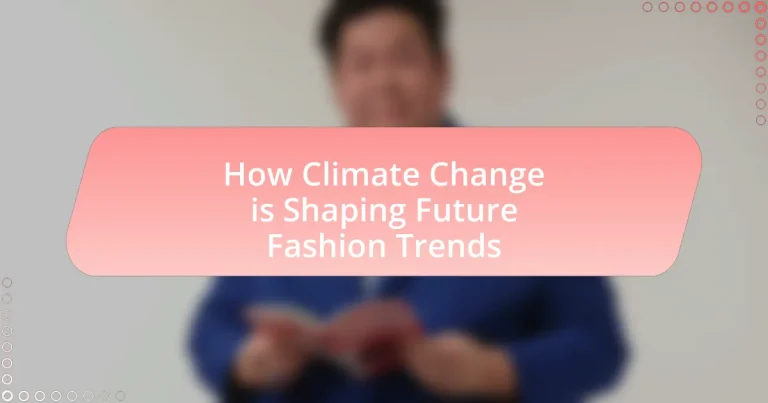The article examines how climate change is reshaping future fashion trends, emphasizing the industry’s shift towards sustainability and eco-friendly practices. It highlights key factors such as increased consumer awareness, resource scarcity, and supply chain disruptions that are driving brands to adopt sustainable materials and ethical production methods. The discussion includes the impact of changing weather patterns on material sourcing, the role of consumer preferences in shaping fashion choices, and the emergence of innovative solutions like upcycled products and local sourcing. Additionally, it addresses the challenges consumers face in accessing sustainable fashion and outlines practical steps individuals can take to support eco-friendly practices in their clothing purchases.

How is Climate Change Influencing Fashion Trends?
Climate change is influencing fashion trends by driving a shift towards sustainable and eco-friendly practices in the industry. As consumers become increasingly aware of the environmental impact of fast fashion, brands are responding by adopting sustainable materials, reducing waste, and implementing ethical production methods. For instance, a report by McKinsey & Company highlights that 67% of consumers consider sustainability when making a purchase, prompting brands to innovate with recycled fabrics and biodegradable materials. This trend reflects a broader movement within the fashion industry to align with global sustainability goals, as evidenced by initiatives like the Fashion Pact, which aims to reduce the industry’s carbon footprint.
What are the key ways climate change is impacting the fashion industry?
Climate change is impacting the fashion industry primarily through increased resource scarcity, supply chain disruptions, and heightened consumer awareness. Resource scarcity arises as climate change affects the availability of raw materials, such as cotton and wool, leading to higher prices and reduced quality. For instance, droughts and extreme weather events have been shown to decrease crop yields, directly influencing textile production. Supply chain disruptions occur as climate-related events, like floods and hurricanes, hinder transportation and manufacturing processes, resulting in delays and increased costs. Additionally, consumer awareness has surged, with studies indicating that over 60% of consumers are now more concerned about the environmental impact of their purchases, prompting brands to adopt sustainable practices. These factors collectively reshape the fashion industry’s approach to production, sourcing, and marketing.
How do changing weather patterns affect material sourcing?
Changing weather patterns significantly impact material sourcing by altering the availability and quality of raw materials. For instance, increased temperatures and unpredictable precipitation can affect agricultural yields, leading to reduced cotton production, which is crucial for the fashion industry. According to the Intergovernmental Panel on Climate Change (IPCC), climate change could reduce global crop yields by up to 25% by 2050, directly influencing the sourcing of natural fibers. Additionally, extreme weather events, such as floods and droughts, can disrupt supply chains and increase costs, making it challenging for manufacturers to secure consistent material supplies. This shift necessitates a reevaluation of sourcing strategies to ensure sustainability and resilience in the face of climate variability.
What role does consumer awareness play in fashion choices?
Consumer awareness significantly influences fashion choices by driving demand for sustainable and ethically produced clothing. As consumers become more informed about the environmental and social impacts of the fashion industry, they increasingly prioritize brands that demonstrate transparency and responsibility in their practices. For instance, a 2021 survey by McKinsey & Company found that 67% of consumers consider sustainability when making fashion purchases, indicating a strong correlation between awareness and purchasing behavior. This shift in consumer preferences compels brands to adopt eco-friendly materials and ethical labor practices, ultimately shaping the future of fashion trends in response to climate change.
Why is sustainability becoming a priority in fashion?
Sustainability is becoming a priority in fashion due to increasing awareness of environmental impacts and consumer demand for ethical practices. The fashion industry is one of the largest polluters globally, contributing to significant carbon emissions, water usage, and waste generation. According to the United Nations, the fashion sector is responsible for 10% of global carbon emissions and consumes around 93 billion cubic meters of water annually. As climate change intensifies, consumers are increasingly seeking brands that prioritize sustainable materials, ethical labor practices, and reduced environmental footprints, prompting companies to adopt more sustainable practices to remain competitive and relevant in the market.
What are the environmental impacts of traditional fashion practices?
Traditional fashion practices significantly contribute to environmental degradation through resource depletion, pollution, and waste generation. The textile industry, which relies heavily on water-intensive crops like cotton, consumes approximately 2,700 liters of water to produce a single t-shirt, leading to water scarcity in many regions. Additionally, the use of synthetic fibers, such as polyester, results in microplastic pollution, with an estimated 500,000 tons of microfibers entering oceans annually from laundry alone. Furthermore, traditional dyeing processes often involve toxic chemicals that contaminate water sources, harming aquatic ecosystems. The overall impact of these practices includes increased carbon emissions, with the fashion industry accounting for about 10% of global greenhouse gas emissions, highlighting the urgent need for sustainable alternatives.
How are brands adapting to sustainable practices?
Brands are adapting to sustainable practices by integrating eco-friendly materials, reducing waste, and implementing ethical production processes. For instance, many fashion companies are now using organic cotton, recycled polyester, and biodegradable fabrics to minimize their environmental impact. According to a 2021 McKinsey report, 67% of consumers consider sustainability when making a purchase, prompting brands to adopt circular economy models that emphasize recycling and reusing materials. Additionally, brands are increasingly transparent about their supply chains, with 75% of companies reporting sustainability initiatives in their operations, reflecting a commitment to social responsibility and environmental stewardship.
What innovations are emerging in response to climate change?
Innovations emerging in response to climate change include the development of sustainable materials, such as bio-based fabrics and recycled textiles. These materials reduce reliance on fossil fuels and minimize waste, addressing the environmental impact of traditional fashion production. For instance, brands are increasingly using materials like Tencel, made from sustainably sourced wood pulp, and recycled polyester, which diverts plastic waste from landfills. Additionally, advancements in circular fashion practices, such as clothing rental and resale platforms, promote resource efficiency and extend the lifecycle of garments. These innovations are crucial as the fashion industry accounts for approximately 10% of global carbon emissions, highlighting the need for sustainable solutions.
How is technology shaping sustainable fashion solutions?
Technology is shaping sustainable fashion solutions by enabling innovative materials, enhancing supply chain transparency, and promoting circular economy practices. For instance, advancements in fabric technology have led to the development of biodegradable textiles and recycled materials, significantly reducing waste. Additionally, blockchain technology is being utilized to trace the origin of materials, ensuring ethical sourcing and production practices. A report by McKinsey & Company highlights that digital tools can help brands reduce their carbon footprint by up to 30% through optimized logistics and inventory management. These technological advancements are crucial in addressing the environmental challenges posed by the fashion industry.
What new materials are being developed for eco-friendly fashion?
Innovative materials being developed for eco-friendly fashion include organic cotton, Tencel (lyocell), and recycled polyester. Organic cotton is cultivated without synthetic pesticides or fertilizers, significantly reducing environmental impact. Tencel, derived from sustainably sourced wood pulp, is biodegradable and produced in a closed-loop process that recycles water and solvents. Recycled polyester, made from post-consumer plastic bottles, diverts waste from landfills and reduces reliance on virgin petroleum-based materials. These advancements reflect a growing commitment within the fashion industry to sustainability and reducing carbon footprints.

How are Consumer Preferences Changing Due to Climate Change?
Consumer preferences are shifting towards sustainable and eco-friendly products due to climate change. This change is driven by increased awareness of environmental issues, leading consumers to prioritize brands that demonstrate commitment to sustainability. For instance, a 2021 survey by McKinsey found that 67% of consumers consider sustainability when making purchasing decisions, indicating a significant trend towards eco-conscious buying behavior. Additionally, the rise of second-hand shopping and rental services reflects a growing preference for reducing waste and extending the lifecycle of clothing, further illustrating how climate change is influencing consumer choices in the fashion industry.
What factors are driving consumers towards sustainable fashion?
Consumers are increasingly driven towards sustainable fashion due to heightened awareness of environmental issues, ethical concerns, and the desire for quality over quantity. Research indicates that 66% of global consumers are willing to pay more for sustainable brands, reflecting a shift in purchasing behavior influenced by climate change and social responsibility. Additionally, the rise of social media has amplified the visibility of sustainable practices, encouraging consumers to support brands that align with their values. This trend is further supported by studies showing that millennials and Gen Z prioritize sustainability in their buying decisions, with 73% of young consumers willing to change their consumption habits to reduce environmental impact.
How does social media influence consumer behavior in fashion?
Social media significantly influences consumer behavior in fashion by shaping trends, facilitating brand engagement, and driving purchasing decisions. Platforms like Instagram and TikTok allow users to discover new styles and brands through influencer marketing and user-generated content, which can lead to increased brand awareness and consumer interest. According to a 2021 survey by McKinsey, 70% of consumers reported that social media influenced their purchasing decisions in fashion, highlighting its critical role in shaping consumer preferences. Additionally, social media enables real-time feedback and interaction between brands and consumers, fostering a sense of community and loyalty that can further impact buying behavior.
What demographic shifts are impacting fashion consumption?
Demographic shifts impacting fashion consumption include the rise of younger, environmentally conscious consumers and the increasing diversity of the population. Younger generations, particularly Millennials and Gen Z, prioritize sustainability and ethical practices in their purchasing decisions, leading to a demand for eco-friendly fashion options. According to a 2021 McKinsey report, 67% of consumers consider the use of sustainable materials important when making fashion purchases. Additionally, the growing diversity in demographics influences fashion brands to cater to a wider range of cultural preferences and body types, reflecting a more inclusive approach to fashion consumption. This shift is supported by data from the U.S. Census Bureau, which projects that by 2045, the U.S. will become a majority-minority nation, further driving the need for brands to adapt to varied consumer identities and values.
Why are second-hand and upcycled fashion gaining popularity?
Second-hand and upcycled fashion are gaining popularity primarily due to increasing environmental awareness among consumers. As climate change concerns rise, individuals are seeking sustainable alternatives to fast fashion, which contributes significantly to pollution and waste. According to a report by the Ellen MacArthur Foundation, the fashion industry is responsible for 10% of global carbon emissions and is the second-largest consumer of water, prompting a shift towards more eco-friendly practices. This shift is reflected in the growing market for second-hand clothing, which is projected to reach $64 billion by 2024, as consumers recognize the benefits of reducing their carbon footprint and promoting circular fashion.
What are the benefits of purchasing second-hand clothing?
Purchasing second-hand clothing offers significant environmental benefits by reducing waste and lowering carbon emissions associated with the production of new garments. The fashion industry is responsible for approximately 10% of global carbon emissions, and by choosing second-hand items, consumers can help mitigate this impact. Additionally, buying used clothing extends the lifecycle of garments, which contributes to a decrease in the demand for new production, ultimately conserving resources such as water and energy. According to a report by the Ellen MacArthur Foundation, extending the life of clothing by just nine months can reduce carbon, water, and waste footprints by around 20-30%.
How do upcycled products contribute to sustainability?
Upcycled products contribute to sustainability by reducing waste and minimizing the demand for new resources. By transforming discarded materials into new products, upcycling diverts waste from landfills, which is crucial as landfills are a significant source of greenhouse gas emissions. According to a study by the Environmental Protection Agency, recycling and composting prevented the release of approximately 186 million metric tons of carbon dioxide equivalent into the air in 2013. This demonstrates that upcycling not only conserves resources but also mitigates climate change impacts, aligning with sustainable practices in the fashion industry.
What challenges do consumers face in adopting sustainable fashion?
Consumers face several challenges in adopting sustainable fashion, primarily including higher costs, limited availability, and lack of awareness. Higher costs deter many consumers, as sustainable clothing often comes with a premium price tag due to ethical production practices and quality materials. Limited availability of sustainable options in mainstream retail channels restricts consumer choices, making it difficult to find eco-friendly products. Additionally, a lack of awareness about the environmental impact of fast fashion and the benefits of sustainable alternatives hinders consumer motivation to make more responsible purchasing decisions. According to a 2021 survey by McKinsey & Company, 66% of consumers expressed a willingness to pay more for sustainable brands, yet only 27% actively seek out sustainable options, highlighting the gap between intention and action.
How does price sensitivity affect sustainable fashion choices?
Price sensitivity significantly influences sustainable fashion choices by limiting consumers’ willingness to pay a premium for eco-friendly products. Research indicates that a substantial portion of consumers prioritize affordability over sustainability, with a survey revealing that 66% of respondents consider price the most important factor when purchasing clothing. This price sensitivity often leads consumers to opt for fast fashion brands that offer lower prices, despite the environmental impact associated with such choices. Consequently, brands focusing on sustainable practices may struggle to attract price-sensitive consumers unless they can effectively communicate the long-term value and benefits of sustainable fashion, such as durability and ethical production.
What barriers exist in accessing sustainable fashion options?
Barriers to accessing sustainable fashion options include high costs, limited availability, and lack of consumer awareness. High costs often deter consumers from purchasing sustainable clothing, as eco-friendly materials and ethical production practices typically result in higher retail prices. Limited availability in mainstream retail outlets restricts consumer access to sustainable brands, making it difficult for shoppers to find these options. Additionally, a lack of consumer awareness about the benefits of sustainable fashion and how to identify sustainable brands further hinders access. According to a 2021 survey by McKinsey & Company, 66% of consumers expressed a desire to buy sustainable products, yet only 27% reported being aware of sustainable fashion brands, highlighting the gap in knowledge and accessibility.

What Future Trends Can We Expect in Fashion Due to Climate Change?
Future trends in fashion due to climate change will include increased use of sustainable materials, a shift towards circular fashion, and the adoption of technology for eco-friendly production. The fashion industry is responding to climate change by prioritizing biodegradable fabrics, recycled materials, and low-impact dyes, which reduce environmental harm. For instance, a report by McKinsey & Company highlights that 67% of consumers consider sustainability when making fashion purchases, indicating a strong market demand for eco-conscious products. Additionally, brands are increasingly implementing circular economy principles, such as take-back programs and upcycling, to minimize waste. This shift is further supported by the Global Fashion Agenda, which emphasizes the need for the industry to reduce its carbon footprint by 30% by 2030.
How will fashion supply chains evolve in response to climate change?
Fashion supply chains will evolve by integrating sustainable practices and technologies to mitigate climate change impacts. This evolution includes adopting circular economy principles, where materials are reused and recycled, reducing waste and resource consumption. For instance, brands like Patagonia and Stella McCartney are leading the way by implementing eco-friendly materials and transparent sourcing practices. Additionally, advancements in technology, such as blockchain for traceability and AI for demand forecasting, will enhance efficiency and reduce carbon footprints. According to a report by McKinsey & Company, the fashion industry could reduce its greenhouse gas emissions by 30% by 2030 through these transformative practices.
What role will local sourcing play in future fashion trends?
Local sourcing will play a significant role in future fashion trends by promoting sustainability and reducing carbon footprints. As consumers increasingly prioritize eco-friendly practices, brands are likely to adopt local sourcing to minimize transportation emissions and support local economies. For instance, a study by McKinsey & Company highlights that 66% of consumers are willing to pay more for sustainable brands, indicating a shift towards local production as a response to climate concerns. This trend not only aligns with environmental goals but also fosters transparency in supply chains, allowing consumers to make informed choices about the origins of their clothing.
How can brands ensure transparency in their supply chains?
Brands can ensure transparency in their supply chains by implementing traceability systems that track the origin and journey of materials. These systems often utilize technologies such as blockchain, which provides an immutable record of transactions and movements, allowing consumers to verify the sourcing and production processes. For instance, a study by the World Economic Forum highlights that companies using blockchain for supply chain transparency can reduce fraud and improve accountability, leading to increased consumer trust. Additionally, brands can engage in third-party audits and certifications, which provide independent verification of ethical practices and sustainability efforts, further enhancing transparency.
What are the potential impacts of climate change on fashion aesthetics?
Climate change significantly impacts fashion aesthetics by altering material availability, influencing design choices, and shifting consumer preferences. As natural resources become scarcer due to climate-related factors, designers may increasingly turn to sustainable materials, such as organic cotton or recycled fabrics, which can reshape traditional aesthetics. For instance, a report by the Global Fashion Agenda highlights that the fashion industry is responsible for 10% of global carbon emissions, prompting a shift towards eco-friendly practices that prioritize minimalism and functionality over fast fashion trends. Additionally, climate change drives a demand for adaptive clothing that can withstand extreme weather, further influencing aesthetic choices in the industry.
How might color and design trends shift due to environmental factors?
Color and design trends may shift towards more sustainable and nature-inspired palettes due to environmental factors. As climate change raises awareness about ecological issues, designers are increasingly incorporating earthy tones, such as greens and browns, to reflect a connection to nature. Additionally, the use of recycled materials and eco-friendly dyes is becoming prevalent, influencing color choices to be more muted and organic. For instance, a report by the Global Fashion Agenda highlights that 66% of consumers are willing to pay more for sustainable fashion, indicating a market shift towards environmentally conscious design. This trend suggests that as environmental concerns grow, color and design will increasingly align with sustainability principles.
What influences will climate change have on fashion marketing strategies?
Climate change will significantly influence fashion marketing strategies by driving brands to adopt sustainable practices and communicate their environmental impact. As consumers increasingly prioritize eco-friendly products, fashion marketers will need to emphasize transparency in sourcing, production processes, and the lifecycle of garments. Research indicates that 66% of global consumers are willing to pay more for sustainable brands, highlighting the necessity for marketing strategies that align with consumer values. Additionally, climate change will push brands to innovate in materials and production methods, necessitating marketing campaigns that showcase these advancements to attract environmentally conscious consumers.
What practical steps can consumers take to support sustainable fashion?
Consumers can support sustainable fashion by choosing to buy from brands that prioritize ethical production practices and use eco-friendly materials. This includes researching companies for their sustainability certifications, such as Fair Trade or Global Organic Textile Standard, which indicate adherence to environmentally friendly practices. Additionally, consumers can reduce their fashion footprint by purchasing second-hand clothing, which extends the life cycle of garments and minimizes waste. According to a report by the Ellen MacArthur Foundation, extending the life of clothes by just nine months can reduce carbon, water, and waste footprints by around 20-30%. Furthermore, consumers can practice mindful consumption by buying fewer, higher-quality items that are designed to last, thus supporting brands that focus on durability over fast fashion.
How can individuals make informed choices when shopping for clothing?
Individuals can make informed choices when shopping for clothing by researching brands’ sustainability practices and understanding the environmental impact of materials used. For instance, consumers can look for certifications such as Global Organic Textile Standard (GOTS) or OEKO-TEX, which indicate eco-friendly production methods. Additionally, studies show that the fashion industry contributes approximately 10% of global carbon emissions, highlighting the importance of selecting brands that prioritize sustainable practices. By choosing clothing made from organic or recycled materials, individuals can reduce their carbon footprint and support environmentally responsible companies.
What are some tips for building a sustainable wardrobe?
To build a sustainable wardrobe, prioritize purchasing high-quality, timeless pieces made from eco-friendly materials. This approach reduces waste and encourages longevity in clothing, as high-quality garments tend to last longer than fast fashion items. According to a study by the Ellen MacArthur Foundation, extending the life of clothing by just nine months can reduce carbon, water, and waste footprints by 20-30%. Additionally, consider second-hand shopping and clothing swaps to minimize environmental impact while diversifying your wardrobe.


